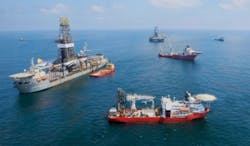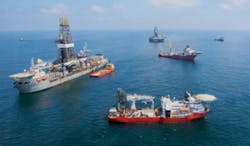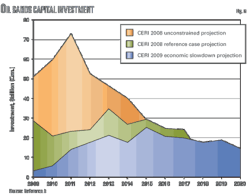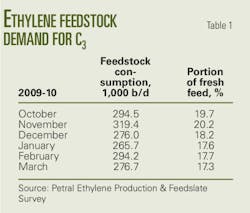BP PLC worked toward using a "top kill" to seal a deepwater blowout and stop an oil spill in the Gulf of Mexico while workers also collected a growing share of the leaking oil.
Doug Suttles, chief operating officer of BP Exploration & Production, expected BP could use a top kill technique, possibly starting May 23-24, to stop the flow.
A final decision on using the top kill procedure has yet to be made, he said May 19, noting that BP continued to collect pressure readings and other information about the damaged blowout preventer.
A top kill would involve pumping heavy fluids through 3-in. choke and kill lines on the existing BOP. A control pod from the BOP was retrieved and was being modified so that BP could control valves during the top kill procedure.
Meanwhile, a riser insertion tool was estimated to be collecting 3,000 b/d of oil leaking from a deepwater well off Louisiana on May 19. Collection efforts started May 16 with 1,000 b/d. The estimated total leak is 5,000 b/d.
The riser insertion tool is a 4-in. steel pipe inserted about 5 ft into a 21-in. damaged riser on the seabed.
"This remains a new technology, and both its continued operation and its effectiveness in capturing the oil and gas remain uncertain," BP said.
Collection tool works
BP gradually increased the volume collected through the riser insertion tool to prevent possible problems with gas hydrates.
A crew on Transocean Ltd.'s Discoverer Enterprise drillship separated the collected oil and gas. The oil was stored, and the gas was flared.
The riser insertion tool, installed in the end of a damaged riser, was about 600 ft from the runaway Macondo well on Mississippi Canyon Block 252. The well reached 18,000 ft TD in 5,000 ft of water.
An Apr. 20 blowout resulted in a fire and explosion on Transocean's Deepwater Horizon semisubmersible rig. BP operates the block.
"We will never produce oil from this well," Suttles said. "We want to be very clear about that." The well has flowed in an uncontrolled manner, and it cannot be repaired, he said. "The right thing to do is to permanently plug this well."
Two relief wells were being drilled with plans to permanently seal the bottom of the well with cement. Transocean's Development Driller III semi started drilling the first relief well on May 2. The Development Driller II started drilling a backup relief well on May 16.
It takes 3 months to complete a relief well, Suttles said.
Slick nears Florida
Satellite imagery on May 18 indicated a tendril of oil sheen was likely to become entrained in the Loop Current, which could pull the sheen toward the Florida Keys and the east coast of Florida.
The Loop Current could take the oil sheen through the western Straits of Florida where the US prohibits leasing for oil and gas exploration. However, Repsol-YPF SA and other companies have exploration acreage off Cuba in that area (See map, OGJ, Dec. 11, 2000, p. 42).
"Both the location of the Loop Current and the oil slick are dynamic—moving around from day to day," said Jane Lubchenco, administrator of the National Oceanic and Atmospheric Administration during a May 18 news conference.
Some tar balls were found at Dry Tortugas National Park, Fla., and on Florida Key beaches but analysis at a US Coast Guard laboratory conclusively showed on May 19 the tar bars did not match the oil from the blowout.
"In the time it would take for oil to travel to the vicinity of the Loop Current, any oil would be highly weathered and the natural processes of evaporation and dispersion would reduce the oil volume significantly," Lubchenco said.
EPA approves subsea dispersants
Environmental Protection Agency Administrator Lisa Jackson on May 14 announced federal officials approved the subsea application of chemical dispersants.
The dispersants break up the oil enabling it to degrade faster. Dispersants were applied at both seabed and on the surface of the water.
"Let me be clear that EPA reserves the right to halt the usage of subsurface dispersant if we conclude that, at any time, the impact to the environment outweighs the benefit of dispersing oil," Jackson said.
EPA and NOAA monitored subsurface dispersant applications and took water samples to understand the impacts to the environment.
"This data will come to EPA once a day and if the levels in the samples are elevated, EPA will reconsider the authorization of use of dispersants," Jackson said.
The authorization followed three tests of subsea dispersants. The first two tests had "logistical problems" in getting the needed information from 5,000 ft of water, Jackson said.
NOAA's Lubchenco said dispersants being used both on the surface and at the seabed are less toxic than the spilled oil.
"This oil spill is unprecedented and dynamic," Lubchenco said.
EPA's Dana Tulis, acting director of the EPA Office of Emergency Management, said no dispersants were applied within 3 miles of shore.
Some 640,000 gal of dispersant had been deployed by May 18 with 53,000 gal of that applied at the seabed using coiled tubing and the rest applied on the surface using airplanes.
It's the first time the use of dispersants at this deep subsea has been permitted, and government agencies continue to monitor water samples to determine its effectiveness and possible environmental consequences. Dispersants break up the oil so that it degrades faster.
On the surface, controlled burns of oil on open water were used May 17-19. More than 20,000 people were involved in the oil spill response.
More than 7 million gal of an oil-water mix has been recovered. BP had spent more than $500 million on the oil spill response as of May 17.
More Oil & Gas Journal Current Issue Articles
More Oil & Gas Journal Archives Issue Articles
View Oil and Gas Articles on PennEnergy.com





